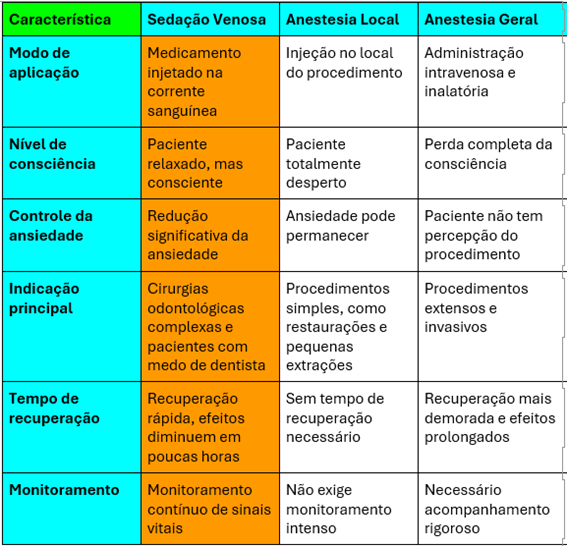What you will find in this article:
- What is intravenous sedation?
- Who is this type of sedation indicated for?
- How is intravenous sedation administered?
- Benefits of intravenous sedation
- Dentist with intravenous sedation in Rio de Janeiro
Intravenous sedation is the secret to ensuring greater comfort and tranquility for patients undergoing dental surgeries, especially those who are afraid of dentists and treatments.
Still not familiar with this type of sedation? Here, you can find out everything you need to know about the subject. Follow along and discover how intravenous sedation can transform your experience during dental surgeries.
What is intravenous sedation?
First, it is important to know what intravenous sedation is. It is an anesthesia technique that uses medication applied directly into the bloodstream, through a vein.
It induces a state of deep relaxation and reduces the patient's awareness during the procedure. It is different from local anesthesia, which blocks pain only at the treatment site. The intravenous version acts on the central nervous system, providing a state of calm and tranquility.
The method is used in complex dental surgeries. The patient remains conscious, but in a state of deep relaxation. The result is a significant reduction in anxiety and discomfort, making the experience more peaceful.
The dentist can work with precision since the patient remains still and cooperative during the procedure. Intravenous sedation is safe when performed by a trained professional in an environment equipped with resources to monitor the patient's vital signs.
Who is this type of sedation indicated for?
The consensus is that intravenous sedation is intended for patients who have high levels of anxiety or fear of dentists and dental procedures.
It is an alternative for those who need to undergo long and complex surgeries. Sedation ensures comfort for the patient, who remains still during the procedure, facilitating the process.
There are cases in which this type of sedation is more indicated, such as those shown below:
-
-
- Extraction of wisdom teeth, which can be a time-consuming and uncomfortable procedure for the patient;
- Dental implant placement, which tends to cause anxiety in the patient. Sedation makes the experience more peaceful;
- Periodontal surgery, such as bone or gum grafting. With sedation, the patient remains comfortable at all times;
- Patients with an exacerbated gag reflex, which can be stimulated by dental instruments in the mouth. Sedation reduces this reflex, which can interfere with the procedure;
- Children and adults with special needs can benefit from sedation, helping the procedure to be performed safely.
-
How is intravenous sedation administered?
Sedation administration is simple and safe, but requires a specialized professional and an environment with equipment to monitor vital signs. Here's how the process works:
Patient assessment
This is the initial stage in which the patient undergoes a complete evaluation, including medical history, verification of allergies and health conditions. The evaluation ensures patient safety by identifying contraindications for the use of sedation.
Preparation
The patient is positioned in the dental chair and connected to vital signs monitoring equipment. This allows the patient to check heart rate, blood pressure and blood oxygenation.
Administration of sedative
The dentist or anesthesiologist administers the sedative by inserting a catheter into a vein in the patient's arm or hand. The medication is administered in a controlled manner to induce a state of deep relaxation within a few minutes.
Recovery
This involves monitoring the patient after the procedure until the effects of sedation have diminished. It is recommended that the patient be accompanied by an adult after discharge, as the effects may persist for a few hours, although milder.
Benefits of intravenous sedation
Dental treatment with sedation offers benefits to patients and dentists, especially when performing complex dental surgeries. Check out some of the main ones:
Conscious sedation dentistry eliminates anxiety and fear during dental procedures. Thus, it is possible to make the patient's experience more pleasant.
The intravenous version of sedation does not replace local dental anesthesia, but complements its effect, contributing to the control of pain and discomfort during surgery.
Patients report that they do not remember the details of the surgery, which is ideal for those who have traumas and fears related to dental procedures.
The patient remains still and cooperative throughout the dental procedure, facilitating the dentist's work and increasing the precision of the surgery.
To better illustrate the benefits of intravenous sedation compared to other forms of anesthesia, check out the table below:
Dentist with intravenous sedation in Rio de Janeiro
- Looking for a dentist RJ that works with intravenous sedation? Odonto Liuzzi is the perfect choice! The clinic is a reference in humanized dentistry and provides care focused on providing a safe and comfortable experience for the patient. Odonto Liuzzi has a complete structure, advanced technology and welcoming and comfortable environments. Schedule an evaluation today and take care of your smile with specialists, peace of mind and advanced resources!










 per
per